Discover the 31 Most Dangerous Animals Patrolling South Carolina's Skies
You might be surprised at the number of dangerous animals winging their way across South Carolina’s skies. Although most of these are raptors (including hawks, owls, falcons, vultures, kites, and kestrels), which hunt small animals using their sharp beaks and wicked talons, the state also has its fair share of dangerous flying insects. And that’s not all – among the many animals on this list is the deadliest predator of all time, a creature responsible for killing nearly half of the human beings that have ever lived. Read on to discover 31 dangerous flying animals in South Carolina!
1. American Barn Owl
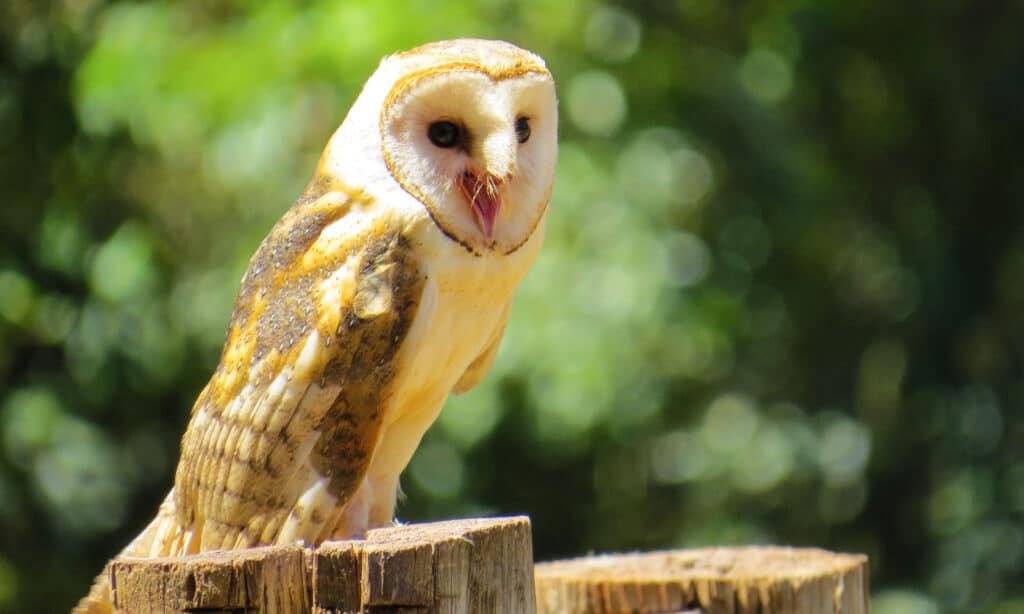
©DEBORA DUARTE LISBOA/Shutterstock.com
- Scientific Name: Tyto furctata
- Length: 12.6 – 15.8 in (32 – 40 cm)
- Weight: 14.1 – 24.7 oz (400 – 700 g)
- Wingspan: 39.4 – 49.2 in (100 – 125 cm)
- Color: Brown, grey, white, red
One of the most dangerous flying animals in South Carolina is the American barn owl. This species is best known for its heart-shaped face and incredible sense of hearing, which enables it to hunt primarily by sound. The species is nonmigratory and inhabits South Carolina all year long, although birdwatchers report that it can be difficult to spot. As its name suggests, it often takes refuge in barns as well as in hollow logs and trees, ranging across open habitats and urban areas.
2. American Kestrel
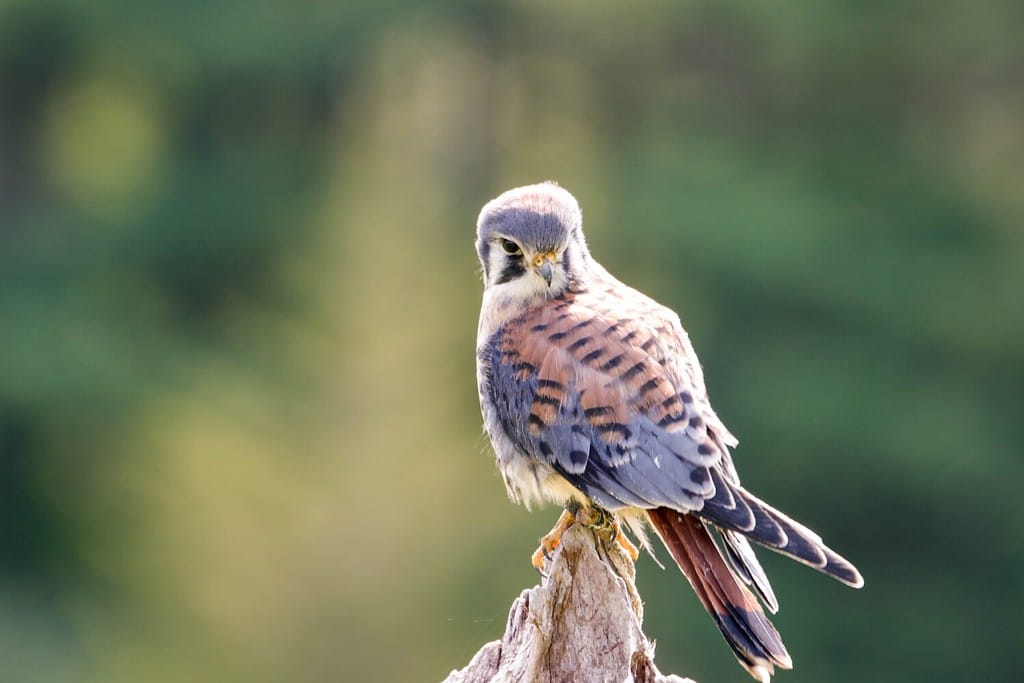
©mynewturtle/Shutterstock.com
- Scientific Name: Falco sparverius
- Length: 8.7 – 15 in (22.1 – 38.1 cm)
- Weight: 2.8 – 6.5 oz (79.4 – 184.3 g)
- Wingspan: 20 – 31 in (50.8 – 78.7 cm)
- Color: Black, brown
The diminutive American kestrel is also known as the sparrowhawk. It inhabits open habitats across South Carolina, perching where it can easily view potential prey. Alternatively, these small falcons often hover on air currents for extended periods of time. Observers have the best chance of spotting them in South Carolina in wintertime, although they occasionally appear at other times of the year.
3. Bald Eagle
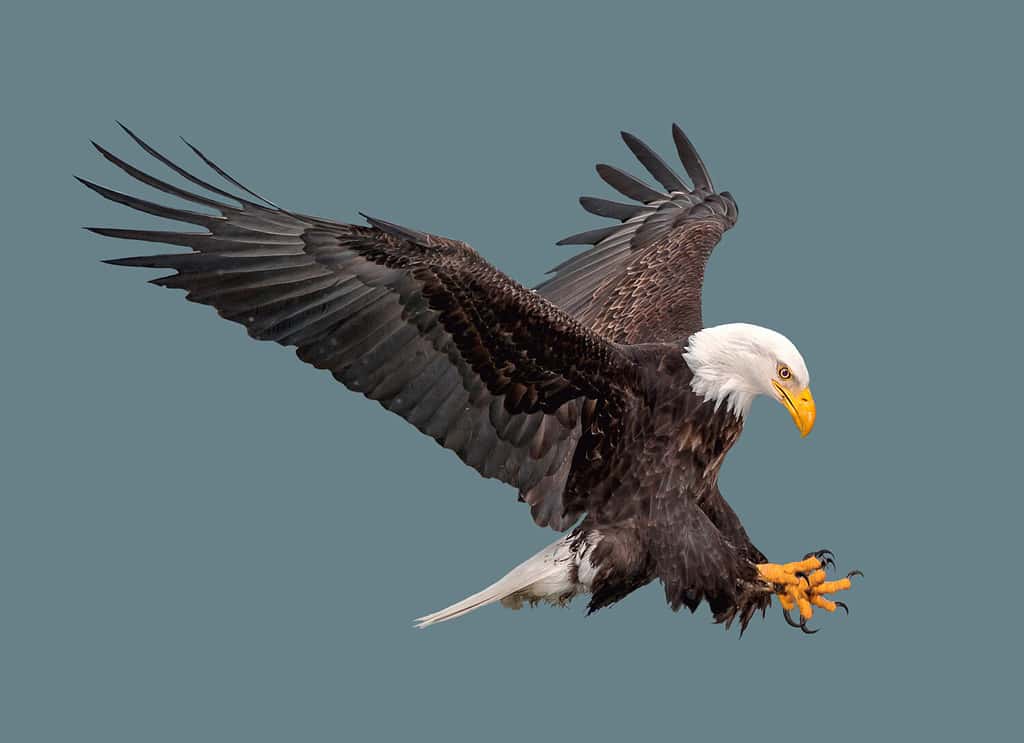
©PHOTOOBJECT/Shutterstock.com
- Scientific Name: Haliaeetus leucocephalus
- Length: 34 – 43 in (86 – 109 cm)
- Weight: 105.6 – 224 oz (2,993.7 – 6,350.3 g)
- Wingspan: 70 – 90 in (177.8 – 228.6 cm)
- Color: Brown, white, yellow
One of the most dangerous flying animals in South Carolina is the bald eagle. This striking raptor is perhaps the most distinctive bird of prey on the planet with its white crown, fierce gaze, and impressive wingspan. However, its cry is somewhat anticlimactic, being little more than a shrill whistle. For this reason, movies and shows featuring the species usually replace its actual call with the ferocious cry of the red-tailed hawk.
It’s possible to catch a glimpse of a bald eagle in South Carolina throughout the year, but the odds are better in winter. This species tends to inhabit wetlands, especially areas near open bodies of water with plenty of fish.
4. Barred Owl
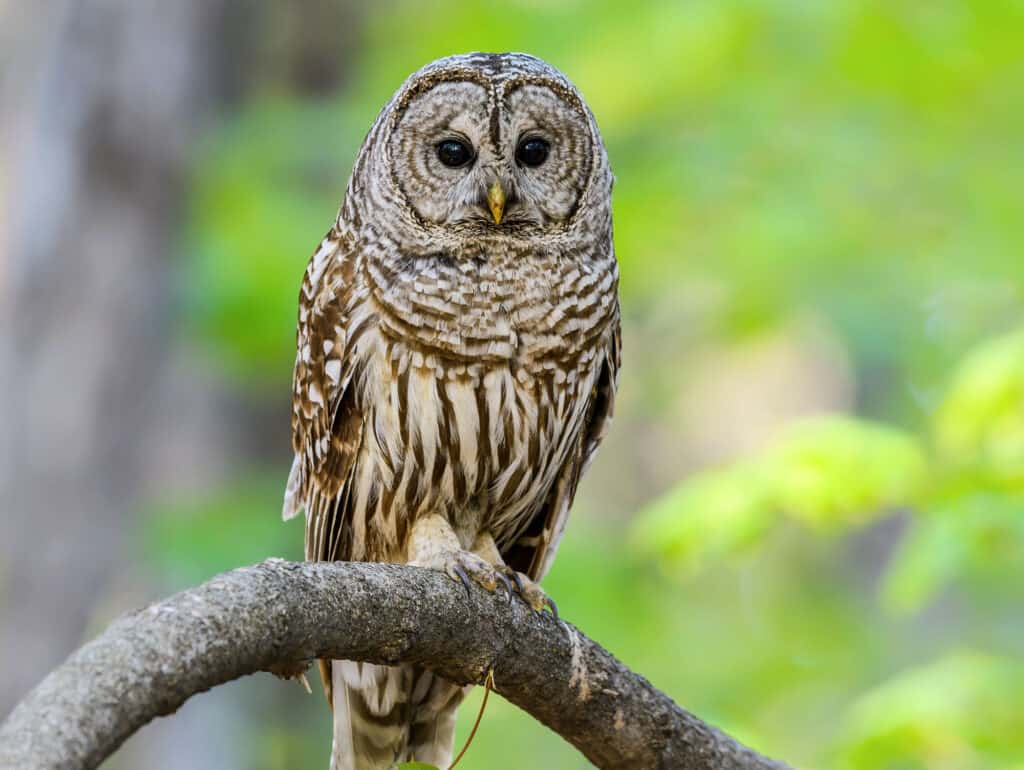
©FotoRequest/Shutterstock.com
- Scientific Name: Strix varia
- Length: 18.9 – 20 in (48 – 50.8 cm)
- Weight: 16 – 32 oz (454 – 907 g)
- Wingspan: 42.1 – 43.7 in (106.9 – 111 cm)
- Color: Brown, grey
The barred owl has a remarkable range of vocalizations including screams, hisses, and something close to laughter. However, its flight is almost completely soundless. Birdwatchers in South Carolina will be delighted to know that barred owls are curious and inquisitive, even appearing friendly at times. Despite their moderate size, they occasionally fall prey to great horned owls.
5. Black Vulture
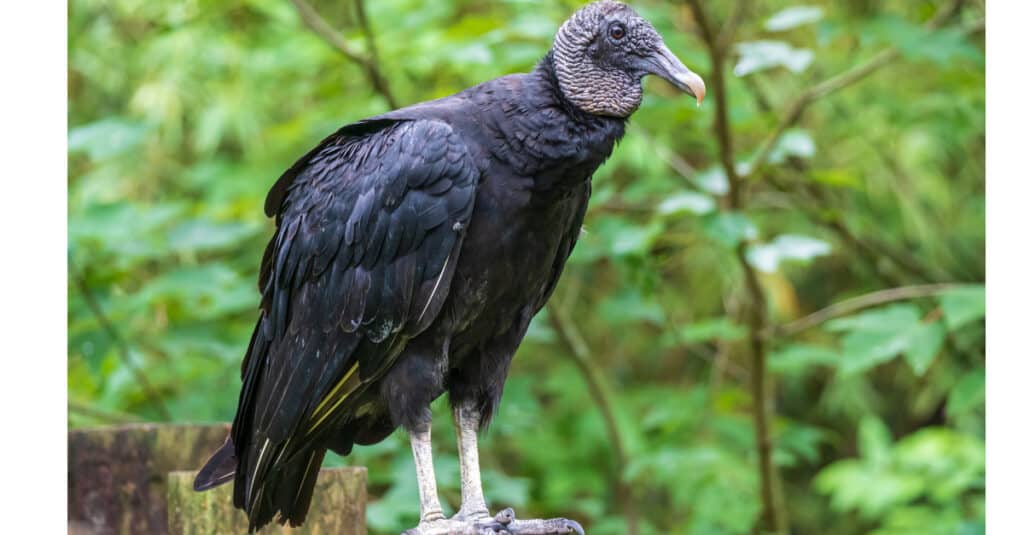
©Holly Guerrio/Shutterstock.com
- Scientific Name: Coragyps atratus
- Length: 23 – 27 in (58 – 69 cm)
- Weight: 76.8 oz (2,177 g)
- Wingspan: 54 – 60 in (137 – 152 cm)
- Color: Black, silver
Vultures have gained a reputation as ugly birds, and the black vulture is no exception. Its signature wrinkled, bald head is likely an adaptation that allows it to stick its head into decaying animals to feed without dirtying its feathers. The species inhabits South Carolina year-round, frequenting open habitats, woodlands, and areas near water. They even venture into urban areas from time to time to feed on garbage.
6. Broad-winged Hawk
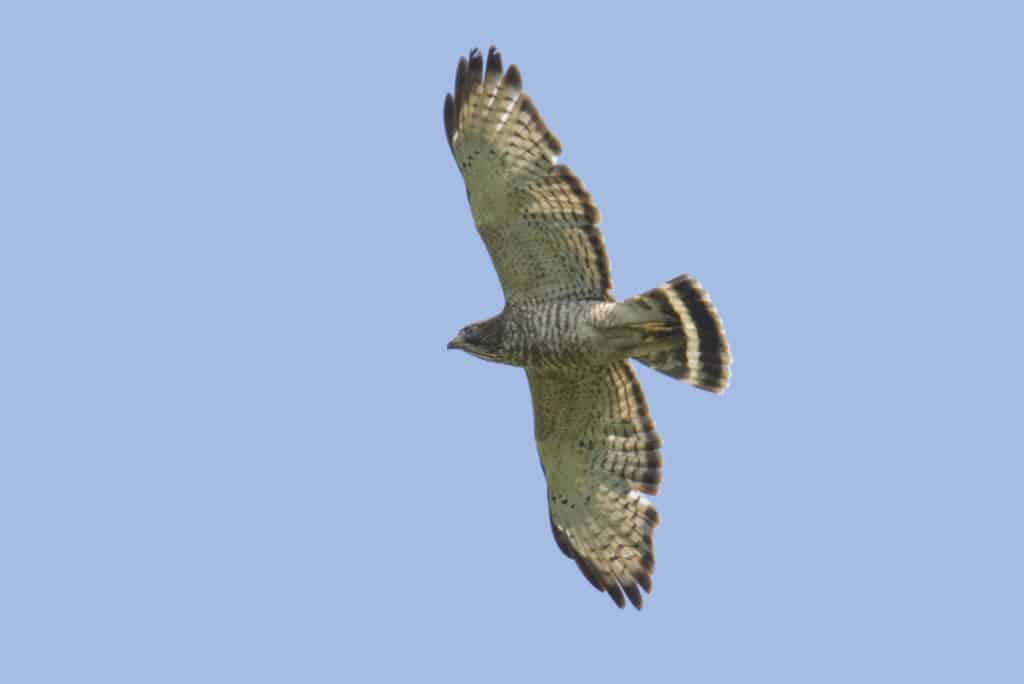
©iStock.com/lrh847
- Scientific Name: Buteo platypterus
- Length: 13.4 – 17.3 in (34 – 44 cm)
- Weight: 9.3 – 19.8 oz (265 – 560 g)
- Wingspan: 31.9 – 39.4 in (81 – 100 cm)
- Color: Reddish-brown
The broad-winged hawk is one of the less common aerial predators in South Carolina. Birdwatchers have the best chance of seeing one during the fall migration. Prior to this, they typically breed in the northwest portion of the state. These raptors are known for reusing the nests of other animals and hunting from high perches.
7. Burrowing Owl
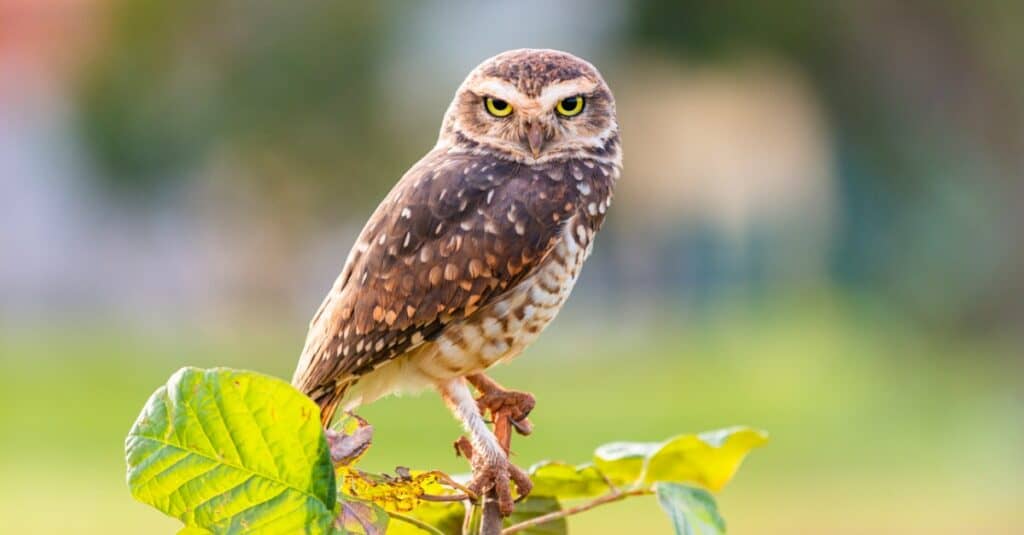
©iStock.com/Philou73
- Scientific Name: Athene cunicularia
- Length: 9 – 11 in (23 – 28 cm)
- Weight: 5.3 oz (150 g)
- Wingspan: 20 – 24 in (51 – 61 cm)
- Color: Brown, white
The burrowing owl gets its name from its habit of living in burrows underground rather than in trees. It uses dung to attract insects to its burrow and manipulate the microclimate. Besides its small, compact body, its slender legs and soft cooing call help distinguish it from other species. The burrowing owl is accidental in South Carolina, making sightings in the state extremely rare.
8. Cooper’s Hawk
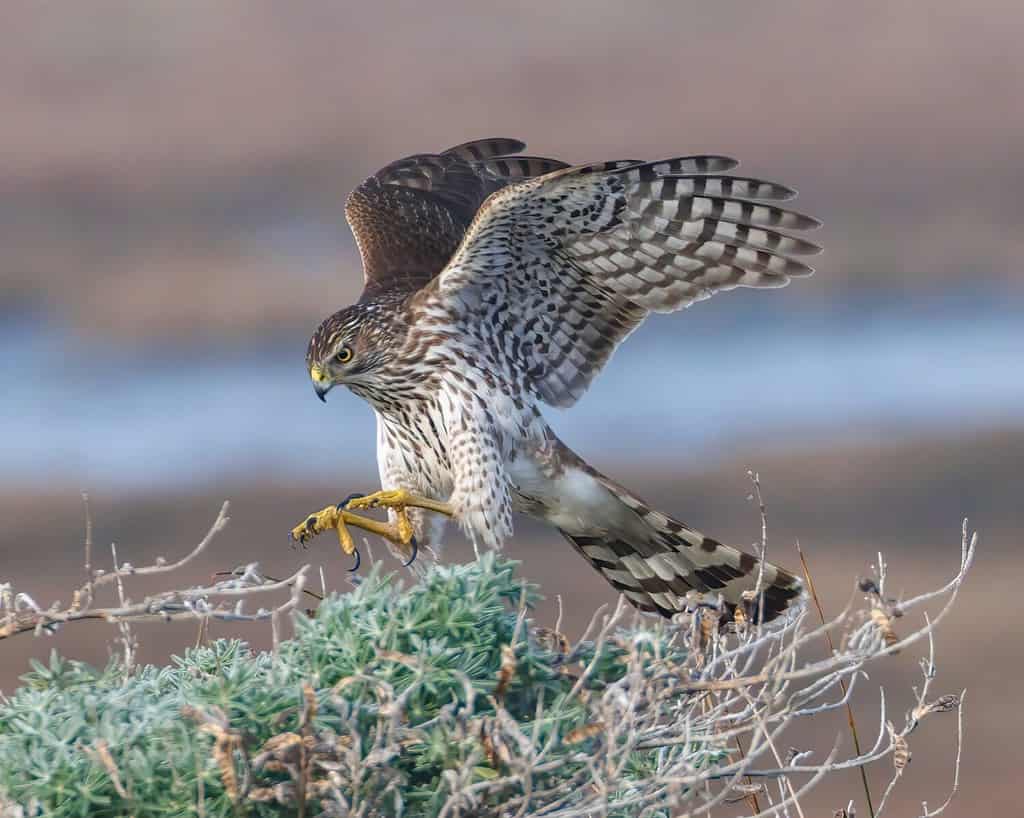
©J. S. Fisher/Shutterstock.com
- Scientific Name: Accipiter cooperii
- Length: 13.2 – 18 in (33.5 – 45.7 cm)
- Weight: 16 – 24 oz (453.6 – 680.4 g)
- Wingspan: 24.4 – 35.4 in (62 – 90 cm)
- Color: Brown, grey, white
Similar in appearance to the sharp-shinned hawk, but larger in size, Cooper’s hawk is a fairly common woodland raptor in South Carolina. It winters in the state, nesting in tall trees and often feeding on smaller birds. It typically lurks on the edges of forests but occasionally appears at bird feeders.
9. Crested Caracara (Northern)
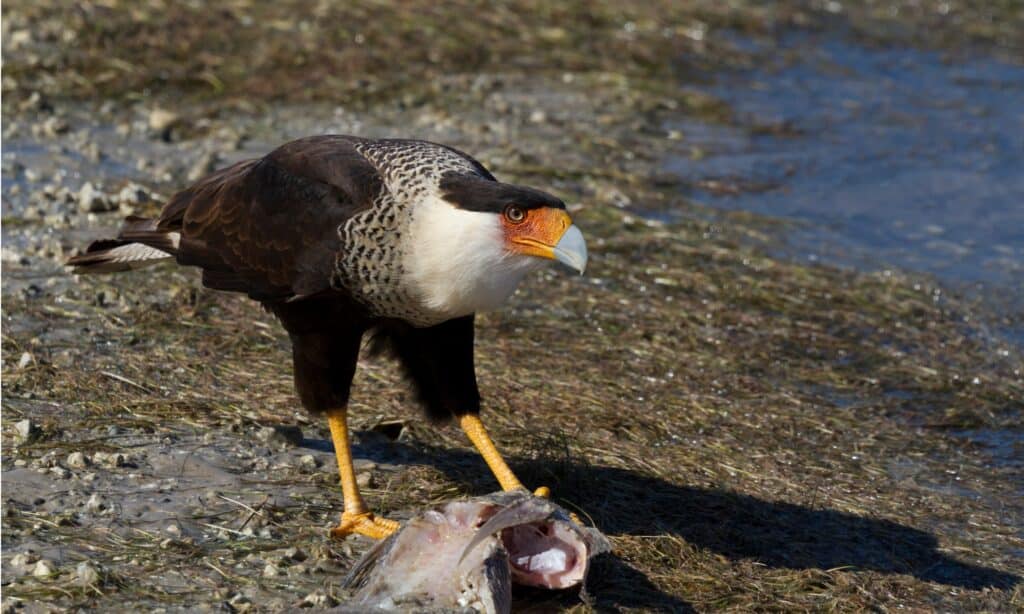
©iStock.com/Florence and Joseph McGinn
- Scientific Name: Caracara plancus cheriway
- Length: 20 – 25 in (51 – 64 cm)
- Weight: 33.6 oz (952 g)
- Wingspan: 45 – 48 in (114 – 122 cm)
- Color: Black, brown, white
The northern crested caracara (also called the Mexican eagle) is a large falcon with a distinctive orange bill. Although some scientists consider it its own species, others classify it as a subspecies of the crested caracara. Because it is an accidental species in South Carolina, sightings are few and far between. This raptor typically haunts open areas like prairies and savannas, perching high in the trees to get a better look at its prey.
10. Eastern Screech Owl
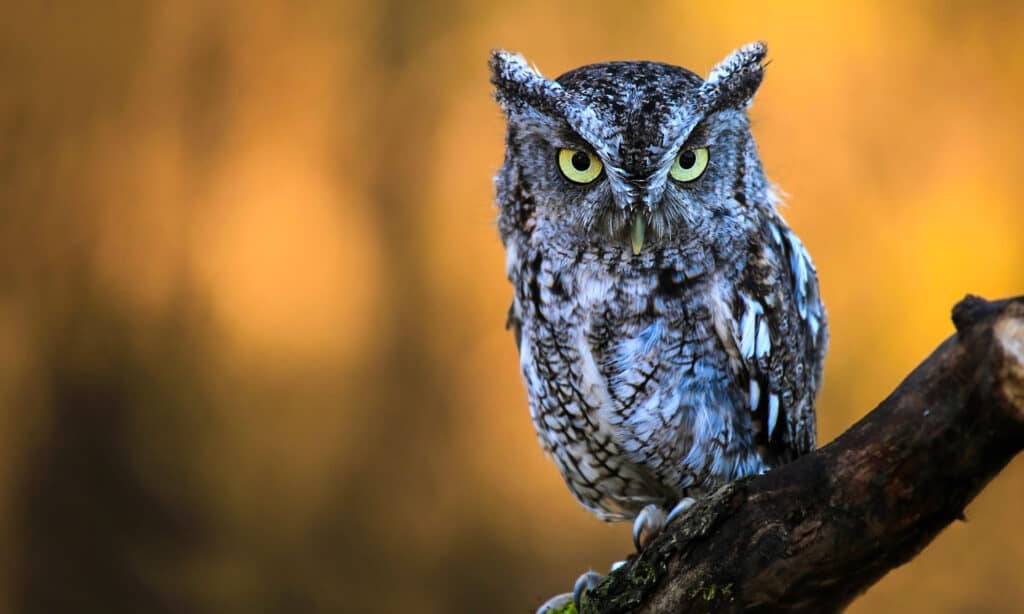
©mlorenz/Shutterstock.com
- Scientific Name: Megascops asio
- Length: 6.3 – 9.8 in (16 – 25 cm)
- Weight: 4.3 – 8.6 oz (121 – 244 g)
- Wingspan: 18.9 – 24.0 in (48 – 61 cm)
- Color: Grey, red
The eastern screech owl is a year-long resident of South Carolina and ranges throughout the eastern half of the United States. Despite being considerably bulkier, these owls aren’t much bigger than a robin. They enjoy lurking in woodlands and parks where they hunt a variety of small mammals, reptiles, amphibians, and insects. Besides their signature screeching call, they have a number of other vocalizations including hoots and whistles.
11. Golden Eagle
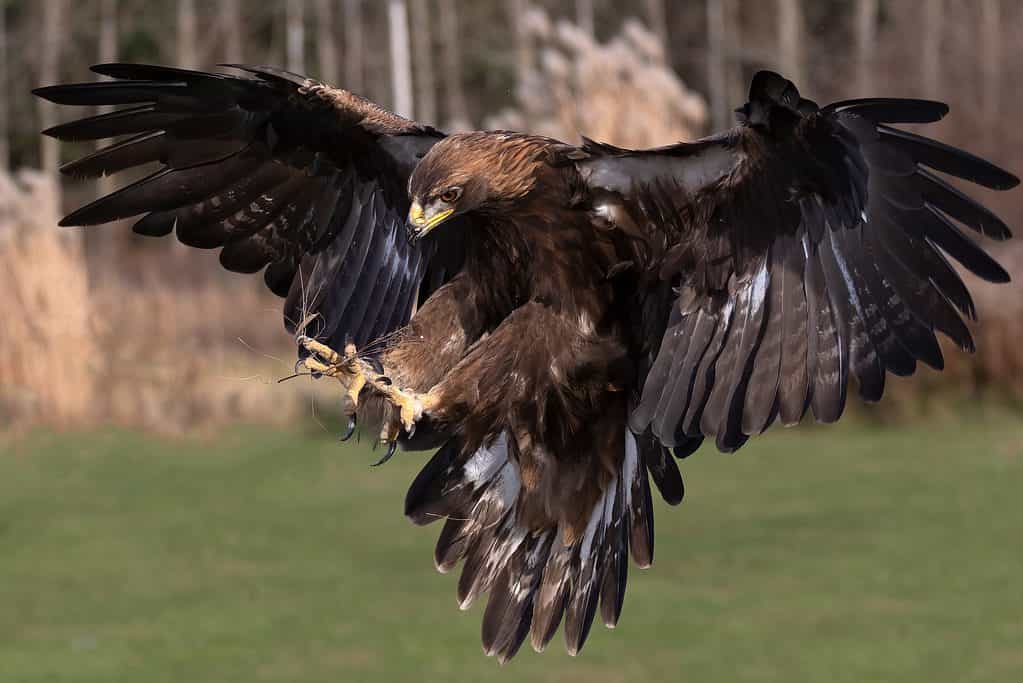
©Touched by light images/Shutterstock.com
- Scientific Name: Aquila chrysaetos
- Length: 26 – 33 in (66 – 83.8 cm)
- Weight: 105 – 216 oz (2,976.7 – 6,123.5 g)
- Wingspan: 84 in (213.4 cm)
- Color: Dark brown, white, gold
The golden eagle is among the most dangerous flying animals in South Carolina. This species ranks as the most widely distributed eagle in the world, though sightings in South Carolina are fairly uncommon. It tends to inhabit mountainous habitats, including canyons and bluffs, and avoids human contact whenever possible. Observers have the best chance of spotting one of these magnificent eagles between October and March. As its name suggests, the species is famous for its rich golden-brown color.
12. Great Horned Owl
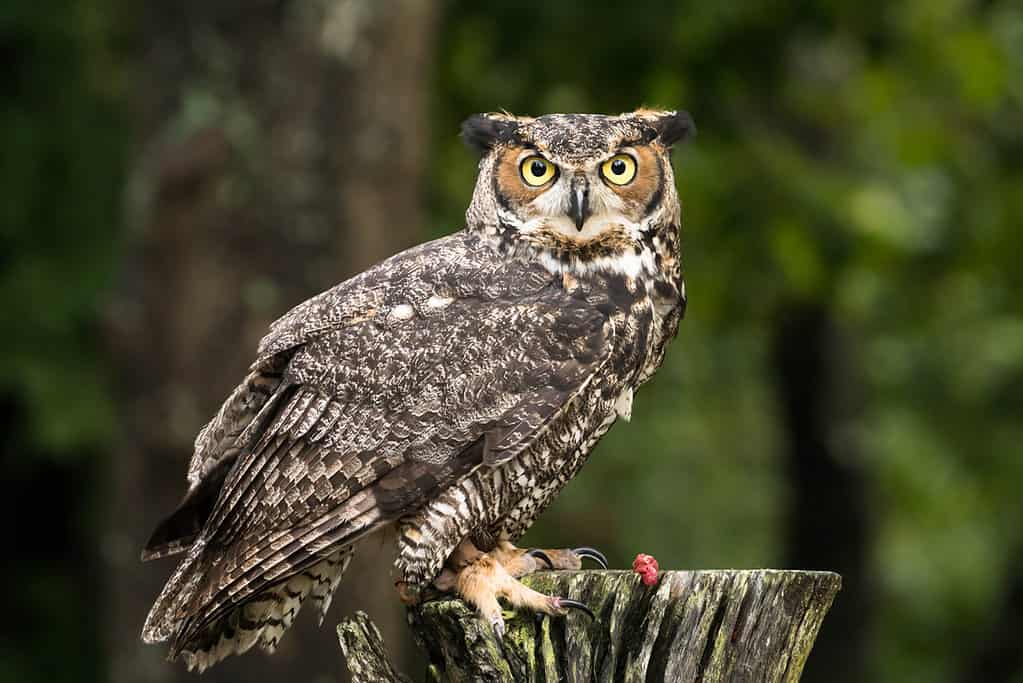
©iStock.com/makasana
- Scientific Name: Bubo virginianus
- Length: 18.1 – 24.8 in (46 – 63 cm)
- Weight: 32.1 – 88.2 oz (910 – 2500 g)
- Wingspan: 39.8 – 57.1 in (101 – 145 cm)
- Color: Black, brown, reddish-brown, grey, white
Few birds of prey are more distinctive than the great horned owl with its prominent horn-like ear tufts. These tufts aren’t merely decorative; it uses them to disguise itself among the tree branches. The species remains in South Carolina all year round, though most sightings occur from September to mid-April. It inhabits virtually any habitat with sufficient prey.
13. Hornets
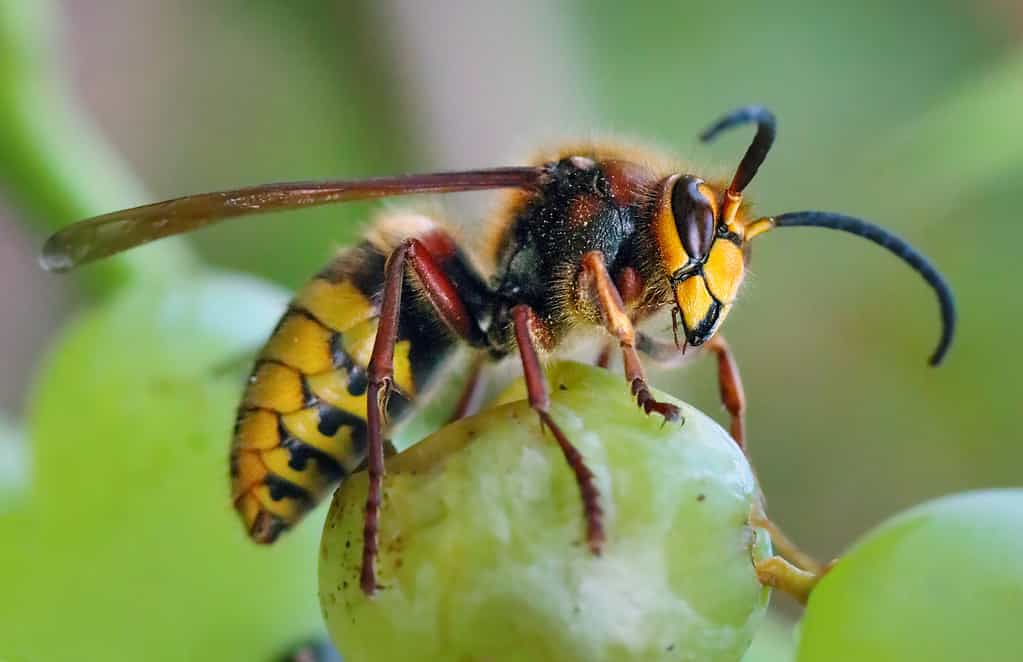
©TTstudio/Shutterstock.com
- Scientific Name: Genus Vespa
- Length: 1 – 2 in (2.5 – 5 cm)
- Color: Black, brown, white, yellow
Besides all the birds of prey in South Carolina’s skies, there are a few dangerous flying insects as well. Hornets are a particularly troublesome group of wasps in South Carolina with their painful stings and their aggressive tendencies. Interestingly, these predators feed primarily on honeybees and fleshy fruits, though they will sting humans if provoked. They can be found across the state during the summer, after which they die off as the cold weather sets in.
14. Long-eared Owl
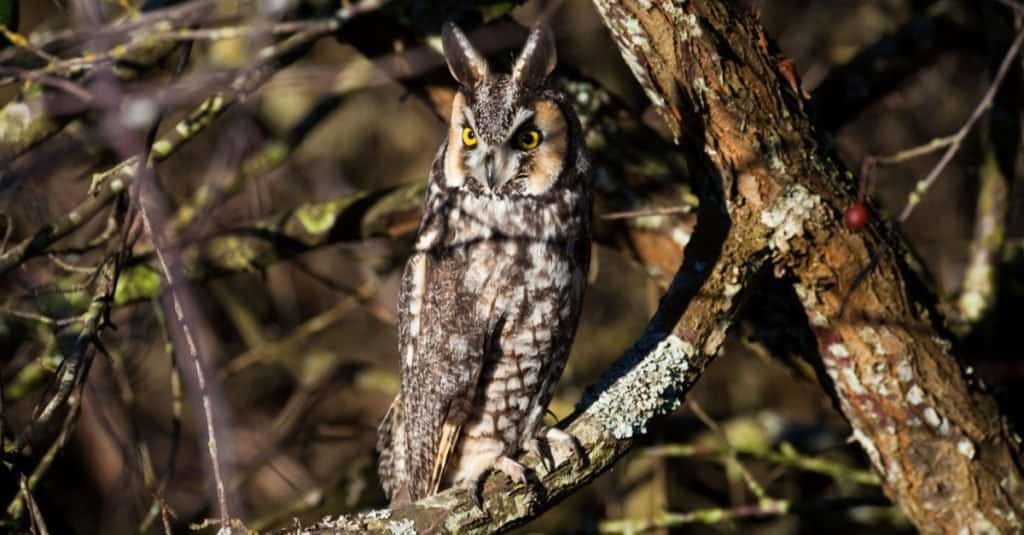
©Feng Yu/Shutterstock.com
- Scientific Name: Asio otus
- Length: 13.8 – 15.8 in (35 – 40 cm)
- Weight: 7.8 – 15.3 oz (220 – 435 g)
- Wingspan: 35.4 – 39.4 in (90 – 100 cm)
- Color: Black, brown, grey, white, orange
Similar to the great horned owl, the long-eared owl gets its name from the prominent tufts of hair on its ears. These tufts make it look larger and more intimidating to other animals, though it also lends them an almost comical air of surprise. The species is accidental in South Carolina, so sightings are few and far between. It tends to hang out in woodlands and grasslands.
15. Merlin
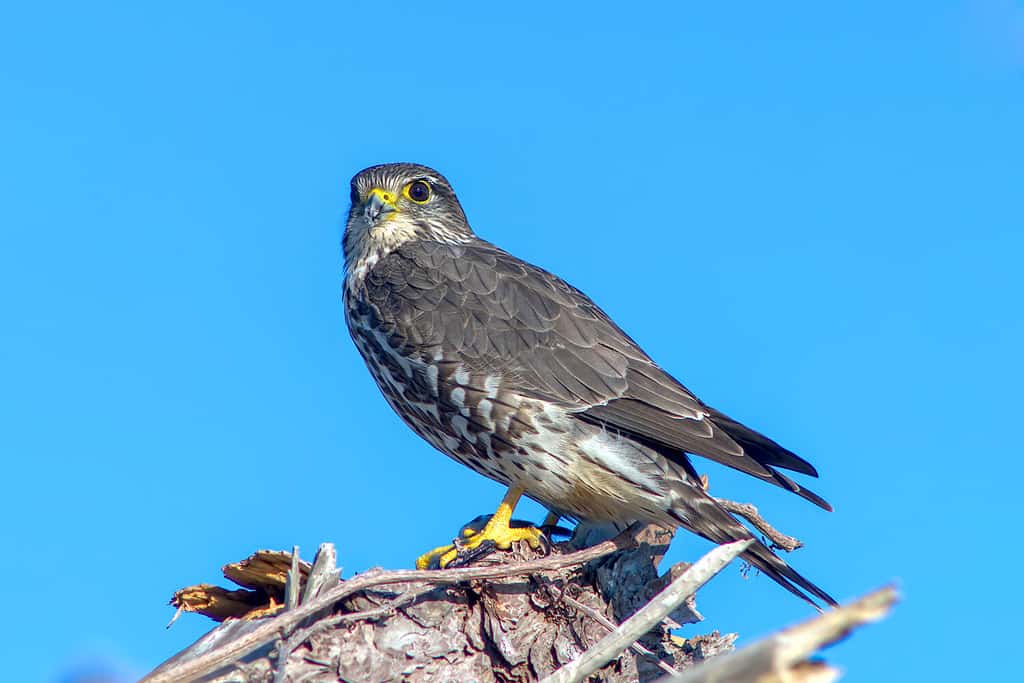
©Noah Li/Shutterstock.com
- Scientific Name: Falco columbarius
- Length: 11 – 13 in (28 – 33 cm)
- Weight: 7.4 oz (210 g)
- Wingspan: 23 – 26 in (58 – 66 cm)
- Color: Blackish-blue, brown, white
The merlin (not to be confused with the fish, marlin) winters in South Carolina and is most commonly spotted from September to April. It primarily hunts smaller birds, pursuing them with its deadly speed until they become too exhausted to flee. Breeding pairs may also hunt together with one chasing its prey into the waiting talons of its mate.
16. Mississippi Kite
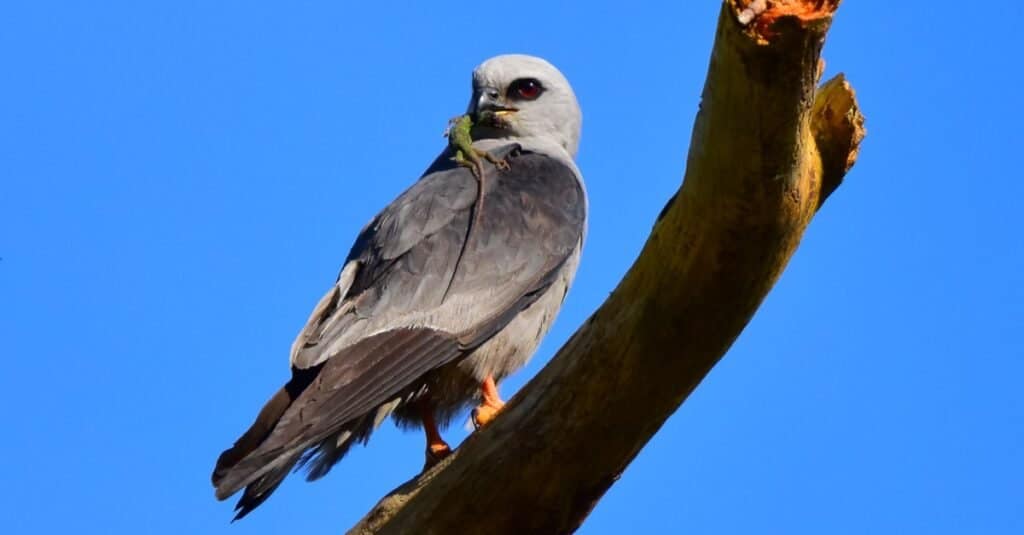
©Chase D’animulls/Shutterstock.com
- Scientific Name: Ictinia mississippiensis
- Length: 13 – 17 in (33 – 43 cm)
- Weight: 7 – 14 oz (198 – 397 g)
- Wingspan: 36 in (91.4 cm)
- Color: Black, dark grey, light grey, white, yellow
The Mississippi kite breeds in South Carolina during the summer, typically arriving in March and migrating to South America in September. It typically inhabits prairie woodlands and old-growth hardwood forests, though it occasionally makes an appearance in urban areas with trees. Its usual hunting tactic is to catch and eat its prey midair.
17. Mosquitoes
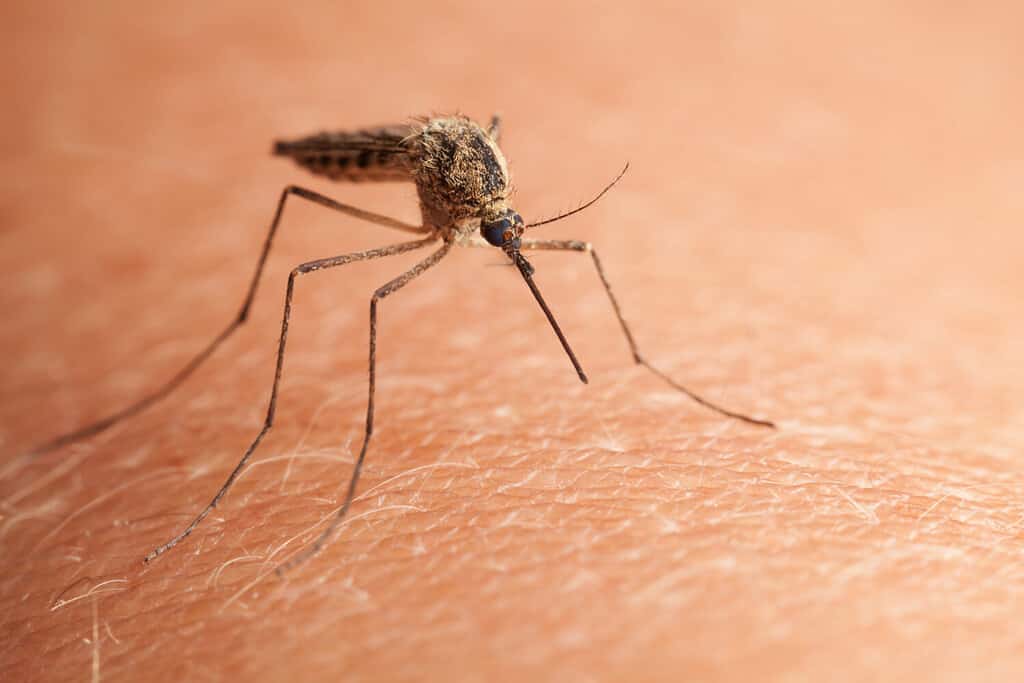
©Anest/Shutterstock.com
- Scientific Name: Family Culicidae
- Length: 0.1 – 1.5 in (0.25 – 3.8 cm)
- Color: Black, brown, white, red
The deadliest animal in all of Earth’s history – and, therefore, the most dangerous flying animal in South Carolina – is the mosquito. Scientists estimate that mosquitoes collectively have killed approximately 52 billion people over the course of human history, nearly half of the (108 billion) humans who have ever lived. Most of the victims were young children. And that’s not even taking into account how many nonhuman animals they’ve killed. There’s no way to know exactly how many of these diseased-carrying terrors inhabit South Carolina, but one thing is certain: no one in the state can escape them for long. Interestingly, only female mosquitoes suck blood, which they use to nurture their eggs.
18. Northern Harrier
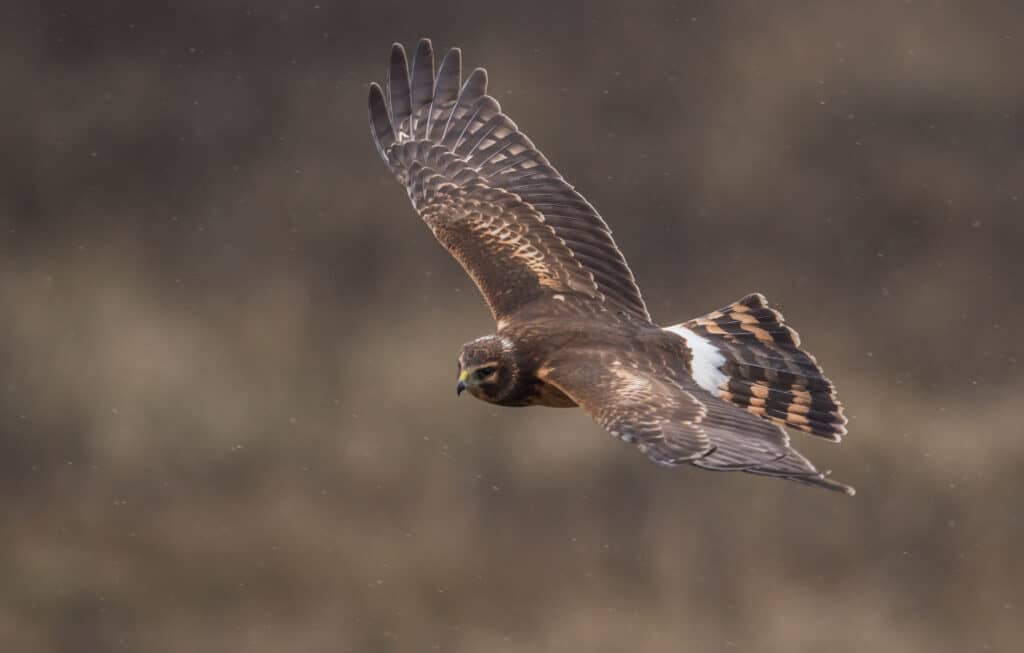
©Harry Collins Photography/Shutterstock.com
- Scientific Name: Circus hudsonius
- Length: 16 – 20 in (40.6 – 50.8 cm)
- Weight: 10 – 26 oz (283.5 – 737.1 g)
- Wingspan: 38 – 48 in (96.5 – 121.9 cm)
- Color: Black, brown, grey, white
Although the northern harrier can fly at speeds of up to 25 miles per hour, it prefers to soar much more slowly at low altitudes. It typically haunts grasslands and marshes, inhabiting South Carolina during the winter months. Unlike the majority of birds, it nests on the ground in thick vegetation.
19. Northern Saw-Whet Owl
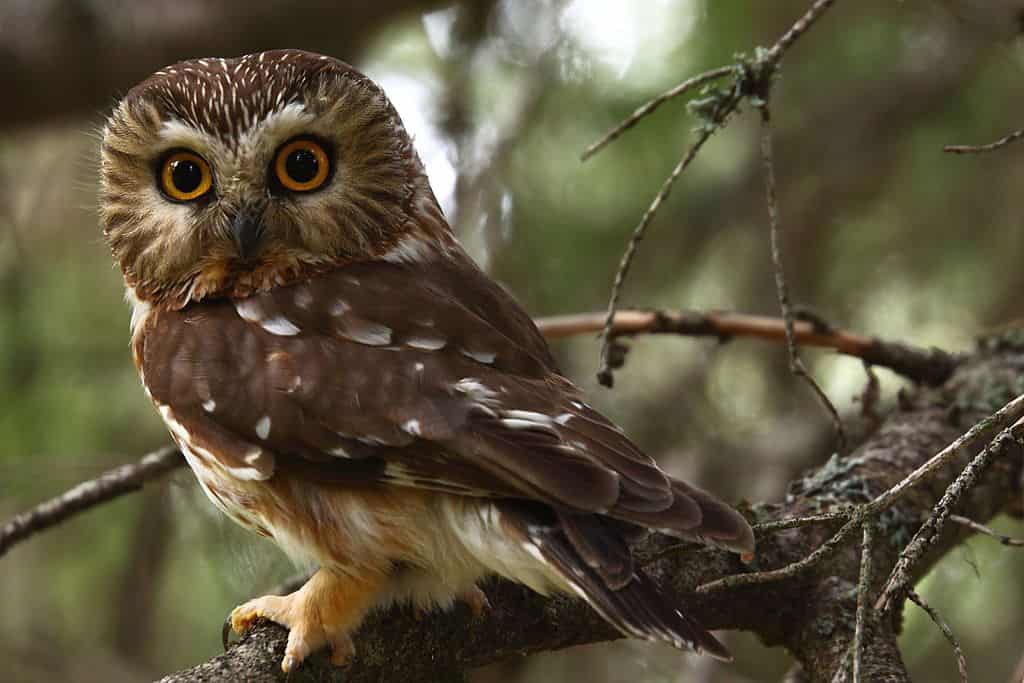
©Kameron Perensovich, CC BY-SA 2.0, via Wikimedia Commons – License
- Scientific Name: Aegolius acadicus
- Length: 7.1 – 8.3 in (18 – 21 cm)
- Weight: 2.3 – 5.3 oz (65 – 151 g)
- Wingspan: 16.5 – 18.9 in (42 – 48 cm)
- Color: Brown, white
The northern saw-whet owl is an accidental species in South Carolina, which means sightings are rare in the state. It typically lurks in dense coniferous forests, though it prefers a water source while hunting. This tiny raptor is only about the size of a robin, making it one of the smallest owls on Earth. Its name comes from its cry, which sounds strangely like the whetting of a saw.
20. Osprey
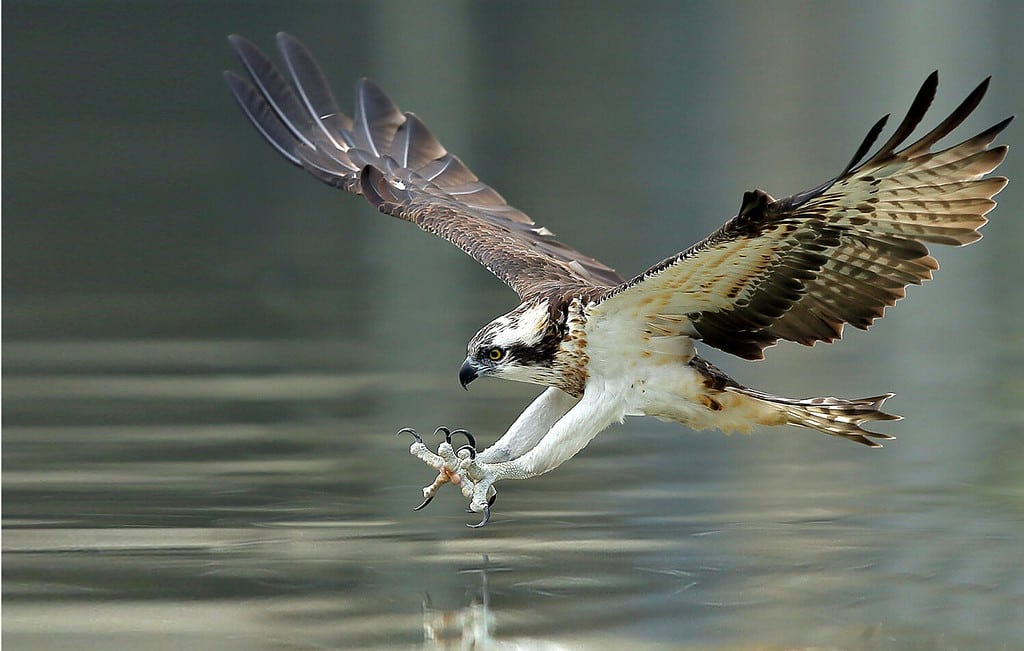
©Wang LiQiang/Shutterstock.com
- Scientific Name: Pandion haliaetus
- Length: 19 – 26 in (48.3 – 66 cm)
- Weight: 32 – 64 oz (907.2 – 1,814.4 g)
- Wingspan: 50 – 71 in (127 – 180.3 cm)
- Color: Brown, white
The osprey is one of the more common raptors in North America and one of the most dangerous flying animals in South Carolina. It usually spends the breeding season in the state from March to November, though observers have spotted them in the south year-round. These ferocious predators have adapted to feed almost exclusively on live fish, which means they typically hang around bodies of water. They are also known as fish hawks or sea hawks.
21. Peregrine Falcon
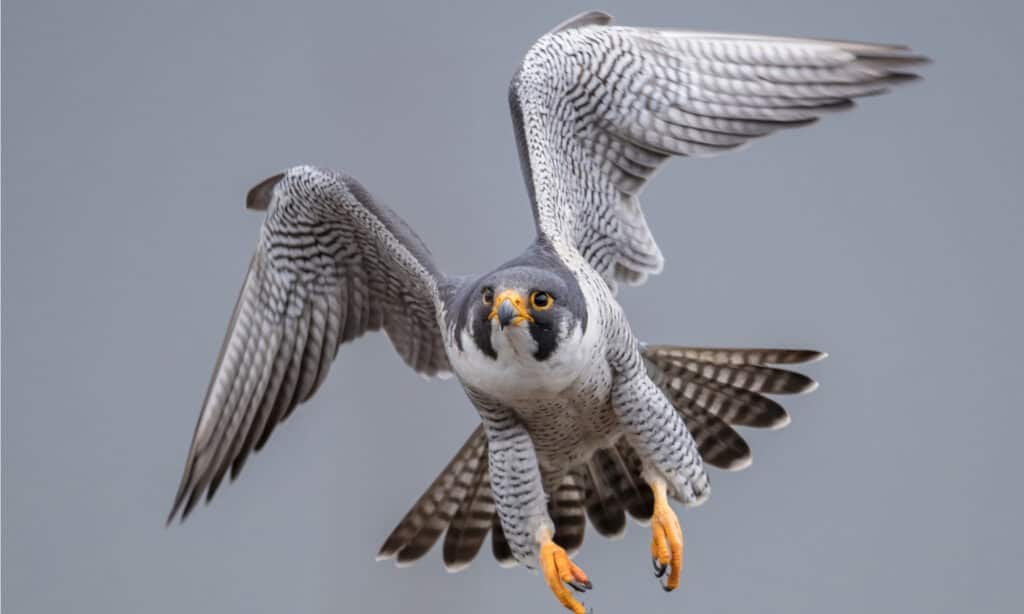
©Harry Collins Photography/Shutterstock.com
- Scientific Name: Falco peregrinus
- Length: 12 – 48 in (30.5 – 121.9 cm)
- Weight: 11.2 – 52.8 oz (317.5 – 1,496.9 g)
- Wingspan: 43 – 46 in (109 – 117 cm)
- Color: Brown, grey, white
One of the most dangerous flying animals in South Carolina is the peregrine falcon. This small raptor reaches astonishing speeds of up to 242 miles per hour, making it easily the fastest animal on Earth. When hunting, it hits its prey with such speed and force that it often kills it on impact. During the winter it lurks along South Carolina’s coast, but birdwatchers have the best chance of spotting it during the September-October migration.
22. Red-shouldered Hawk
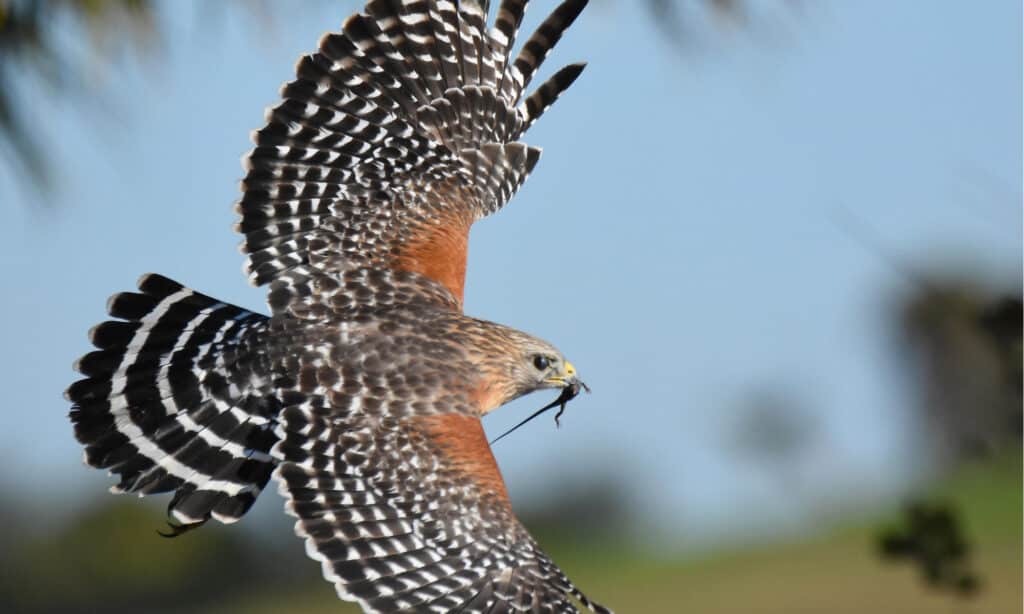
©MTKhaled mahmud/Shutterstock.com
- Scientific Name: Buteo lineatus
- Length: 15 – 24 in (38.1 – 61 cm)
- Weight: 16 – 32 oz (453.6 – 907.2 g)
- Wingspan: 35 – 50 in (88.9 – 127 cm)
- Color: Black, brown, tan, white, red
The red-shouldered hawk is a year-long resident of South Carolina, typically hunting in wet forests. It reuses its nesting site year after year, which is usually located in a tree near water. Its checkered wings and red “shoulders” are highly distinctive.
23. Red-tailed Hawk
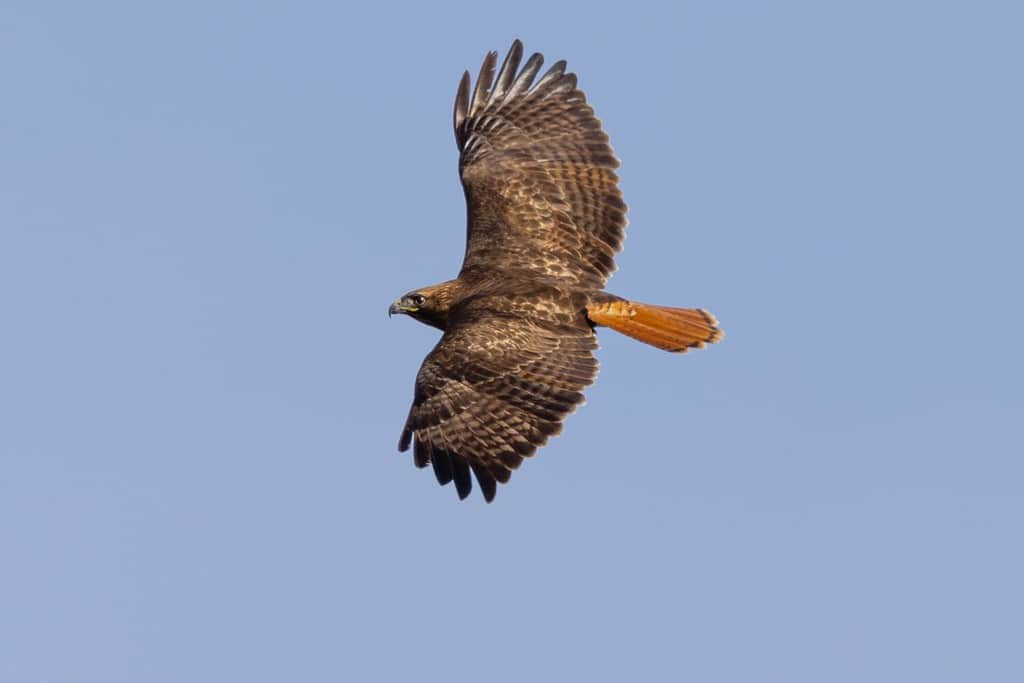
©ranchorunner/Shutterstock.com
- Scientific Name: Buteo jamaicensis
- Length: 17.7 – 25.6 in (45 – 65 cm)
- Weight: 24.3 – 51.5 oz (690 – 1,460 g)
- Wingspan: 44.9 – 52.4 in (114 – 133 cm)
- Color: Reddish-brown, white
The red-tailed hawk is one of the most dangerous flying animals in South Carolina, inhabiting the state year-round. Its claim to fame is its raspy screech, which is so ferociously distinctive that filmmakers often substitute it for the cry of other species like the bald eagle. It typically nests in tall trees or on cliff edges and buildings.
24. Sharp-shinned Hawk
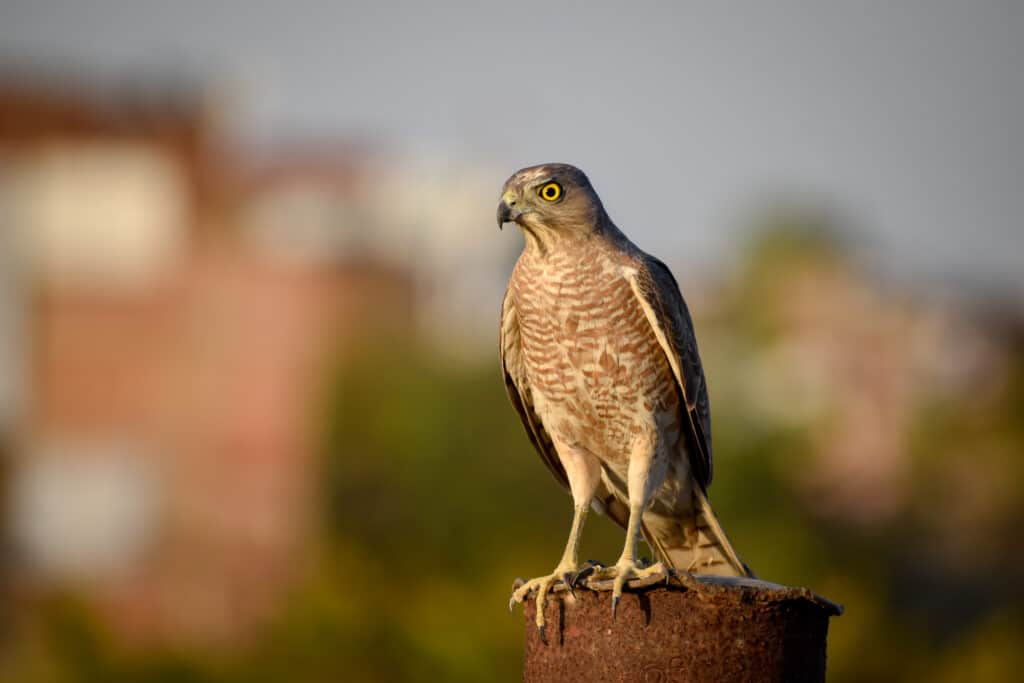
©Vizz Effect/Shutterstock.com
- Scientific Name: Accipiter striatus
- Length: 9 – 15 in (22.9 – 38.1 cm)
- Weight: 3 – 8 oz (85 – 226.8 g)
- Wingspan: 17 – 27 in (43.2 – 68.6 cm)
- Color: Black, grey, white
The sharp-shinned hawk inhabits South Carolina during the winter months, though sightings are rare. The species is both elusive and agile, darting through dense forests or cruising along the treeline. It typically hunts small songbirds like robins.
25. Short-eared Owl
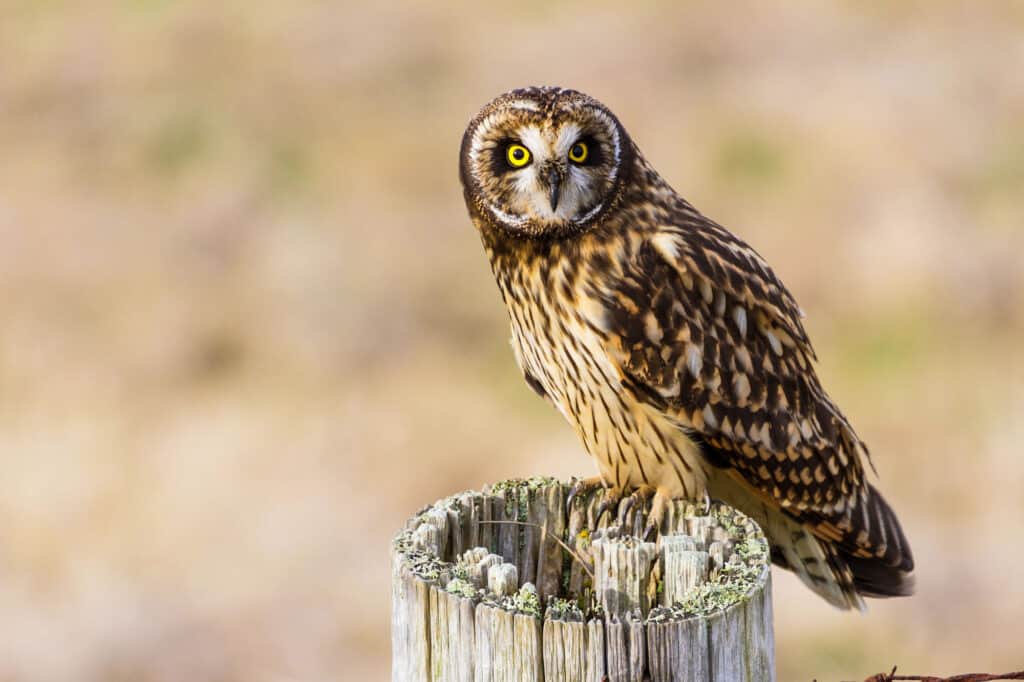
©iStock.com/Devonyu
- Scientific Name: Asio flammeus
- Length: 13 – 17 in (33 – 43.2 cm)
- Weight: 7.3 – 16.8 oz (207 – 476.3 g)
- Wingspan: 43 in (109.2 cm)
- Color: Black, brown, white, yellow
The short-eared owl is uncommon in South Carolina, though observers may spot it along the coast from November to March. As its name suggests, its ear tufts are extremely short, often giving it the appearance of being totally earless. Unlike most owls, it hunts primarily during the day.
26. Snail Kite
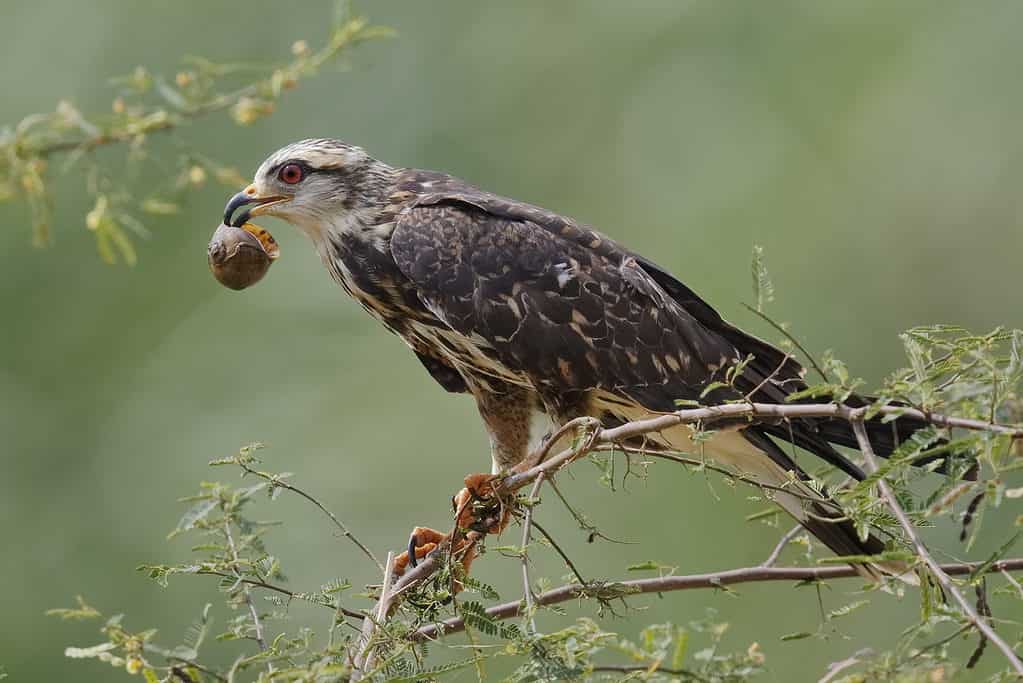
©iStock.com/BrianLasenby
- Scientific Name: Rostrhamus sociabilis
- Length: 16 – 18 in (41 – 46 cm)
- Weight: 13.3 oz (377 g)
- Wingspan: 45 in (114 cm)
- Color: Brown, white
Don’t expect to see many snail kites in South Carolina – these raptors are resident throughout the year in the southern United States, Mexico, and Central and South America, which means they rarely make their way north. However, birdwatchers have caught a few rare glimpses throughout the years. The snail kite is famous for primarily feeding on the apple snail, from which it derives its name. It typically hangs out in wetlands like marshes and shallow lakes as well as tropical woodlands.
27. Snowy Owl
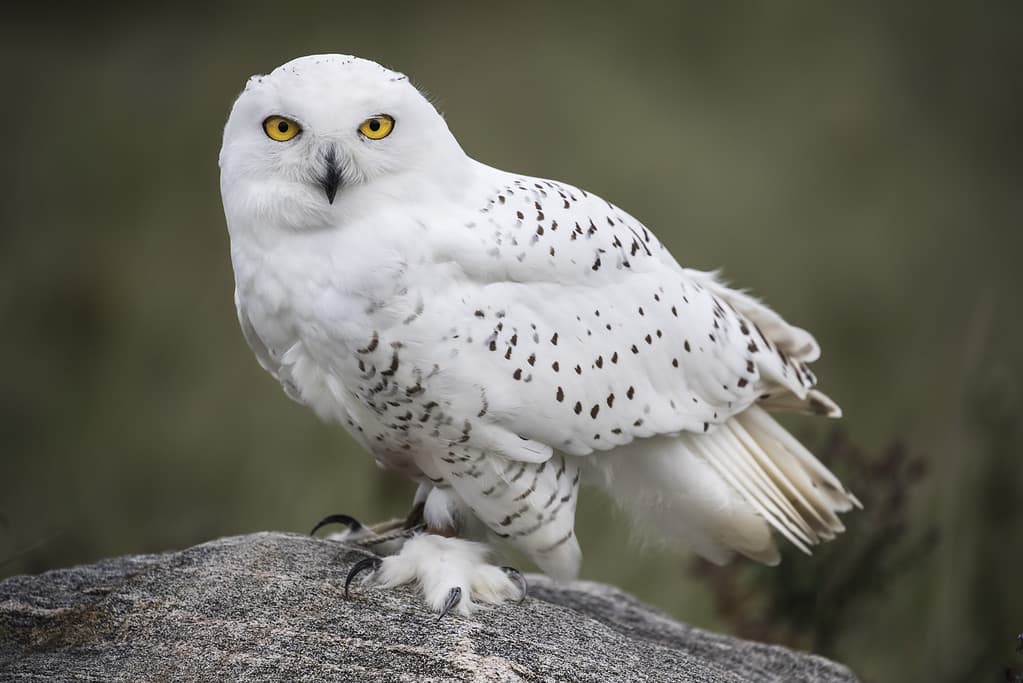
©Carol Gray/iStock via Getty Images
- Scientific Name: Bubo scandiacus
- Length: 20.5 – 27.9 in (52 – 71 cm)
- Weight: 38.4 – 70.4 oz (1,088.6 – 1,995.8 g)
- Wingspan: 51 – 65 in (130 – 164 cm)
- Color: Black, grey, white
The snowy owl is not only one of the largest owl species in the world, but it’s also one of the most beautiful. Its snowy-white features and grey accents are unmistakable against a blue sky – though the species is a lot harder to make out against dense clouds or snow. These owls breed in the Arctic and then migrate south to Canada or the northern United States, including South Carolina. However, sightings of this lovely species are rare as the species is considered vulnerable in the state. It most commonly lurks in grasslands, marshes, and shrubby areas like prairies.
28. Swallow-tailed Kite
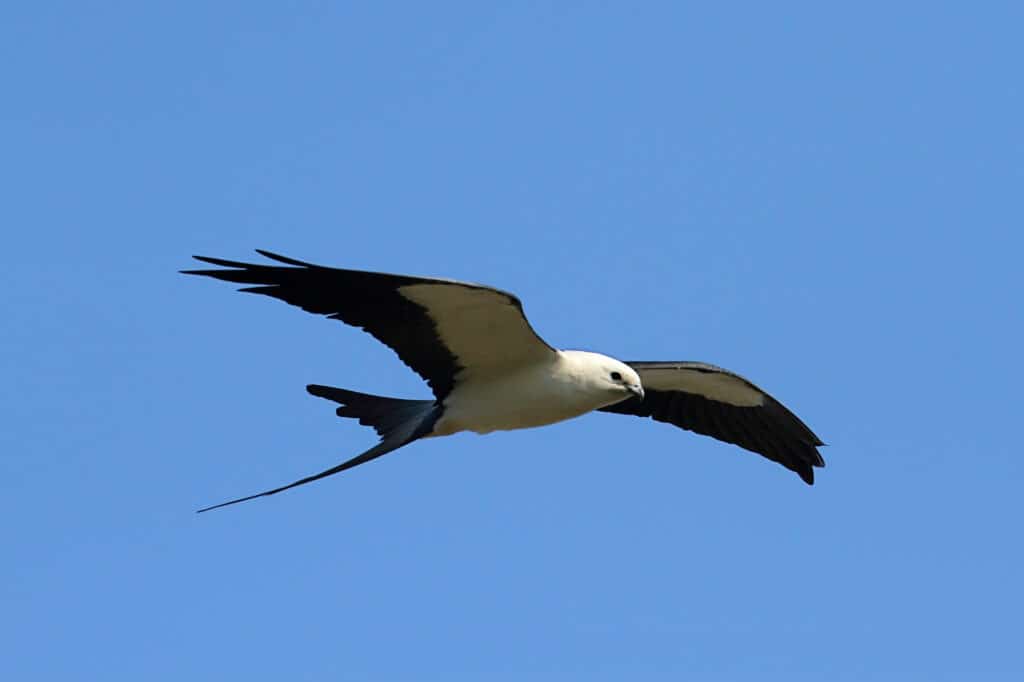
©iStock.com/SteveByland
- Scientific Name: Elanoides forficatus
- Length: 19 – 25 in (48 – 64 cm)
- Weight: 15.6 oz (442 g)
- Wingspan: 45 – 50 in (114 – 127 cm)
- Color: Black, white
The swallow-tailed kite gets its name from its long, forked tail, which resembles that of a swallow. During the juvenile stage, the fork in its tail is less prominent. These raptors breed in South Carolina and can be spotted from March to September. They typically lurk in wetlands like swamps and marshes as well as humid forests. Although their diet varies, they primarily hunt insects.
29. Turkey Vulture
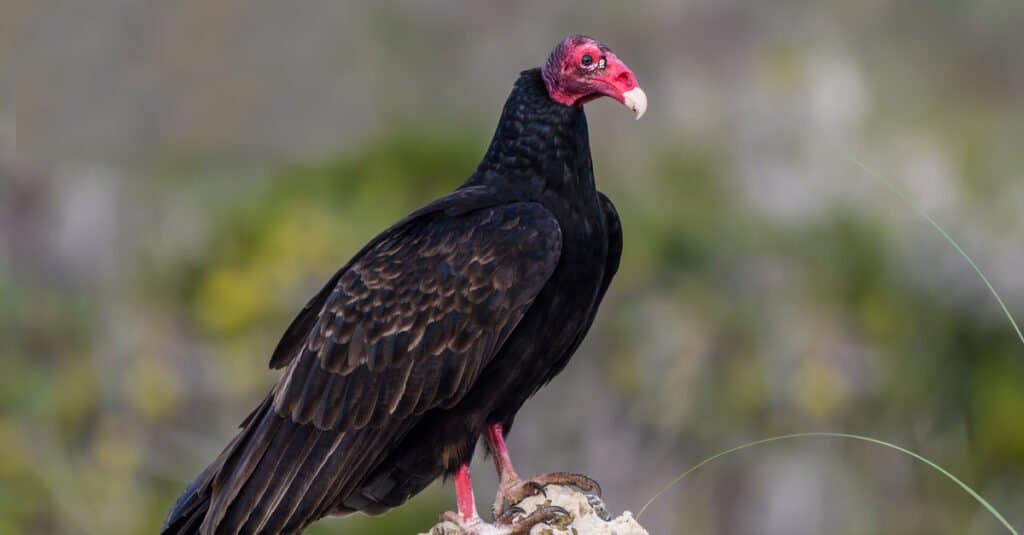
©FotoRequest/Shutterstock.com
- Scientific Name: Cathartes aura
- Length: 30 in (76.2 cm)
- Weight: 32 – 80 oz (907.2 – 2,268 g)
- Wingspan: 63 – 72 in (160 – 182.9 cm)
- Color: Dark brown, red
The second species of vulture in South Carolina is the turkey vulture, which gets its name from its turkey-like reddish head. Alternately, this species is known as the turkey buzzard. These raptors prefer open habitats like grasslands and shrublands with access to tall trees for nesting. They feed primarily off carrion, which means they frequently consume rotting or diseased meat. Their unusually potent stomach acid enables them to digest otherwise harmful substances without getting sick. Because turkey vultures are fairly common and remain in the state all year long, birdwatchers have a good chance of spotting one.
30. White-tailed Kite
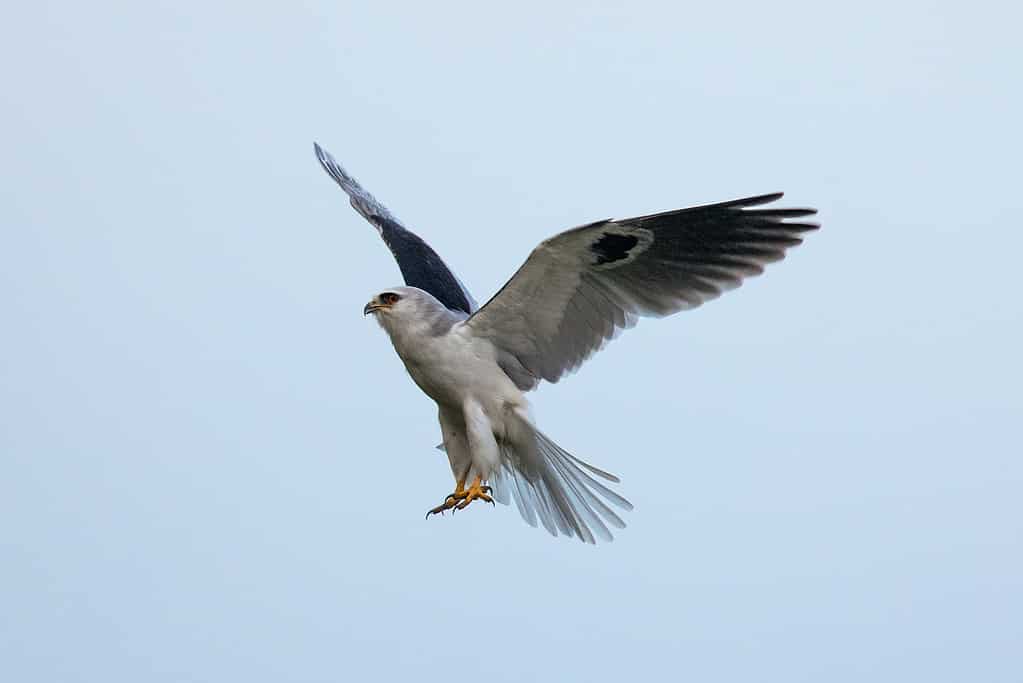
©rancho_runner/iStock via Getty Images
- Scientific Name: Elanus leucurus
- Length: 15 – 17 in (38 – 43 cm)
- Weight: 12 oz (340 g)
- Wingspan: 40 – 42 in (102 – 107 cm)
- Color: Grey, white
The white-tailed kite is a small but graceful raptor with mingled grey and white accents. It engages in a behavior called “kiting,” which entails flapping its wings while facing the wind in order to hover in place. The species is accidental in South Carolina, which means the chances of observing one are extremely slim. It typically inhabits savannas, desert grasslands, and fields, nesting in tall trees.
31. Yellowjackets
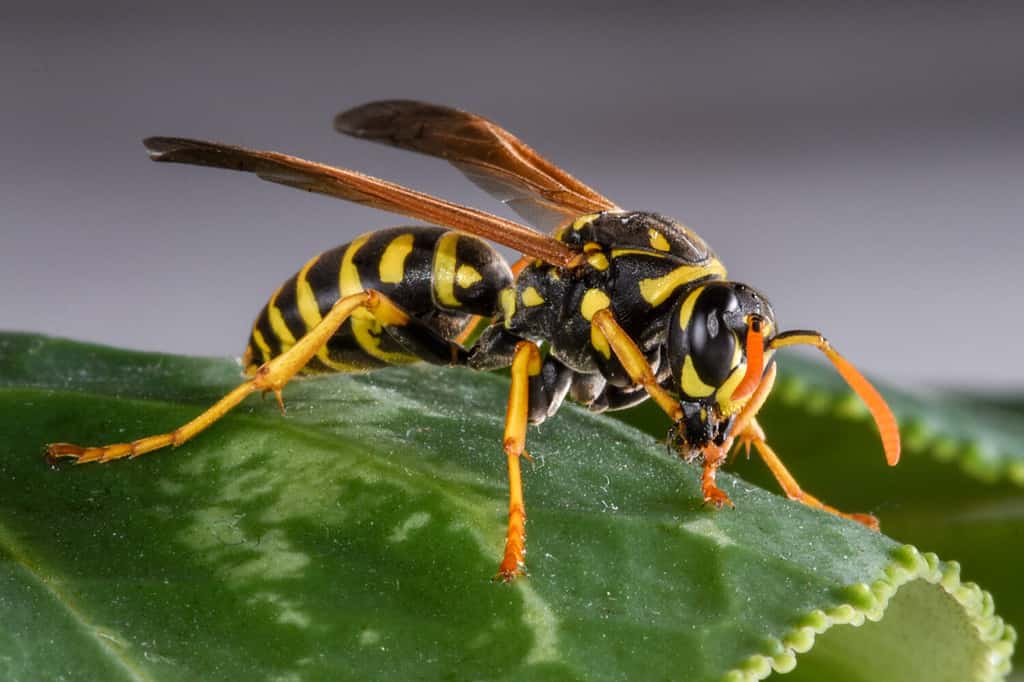
©Randy Runtsch/Shutterstock.com
- Scientific Name: Genera Vespula and Dolichovespula
- Length: 0.47 – 0.75 in (1.2 – 1.9 cm)
- Color: Black, white, yellow, multicolored
Yellowjackets are any of 17 species of wasps belonging to the genera Vespula and Dolichovespula. Known to be highly aggressive, they account for the majority of fatal wasp stings. Their banded yellow and black bodies are easy to recognize. Various species of yellowjackets roam across South Carolina, meaning it is possible to encounter them virtually anywhere in the state.
Summary Table of 31 Dangerous Flying Animals in South Carolina
| Number | Common Name | Scientific Name |
|---|---|---|
| 1 | American barn owl | Tyto furctata |
| 2 | American kestrel | Falco sparverius |
| 3 | Bald eagle | Haliaeetus leucocephalus |
| 4 | Barred owl | Strix varia |
| 5 | Black vulture | Coragyps atratus |
| 6 | Broad-winged hawk | Buteo platypterus |
| 7 | Burrowing owl | Athene cunicularia |
| 8 | Cooper’s hawk | Accipiter cooperii |
| 9 | Crested caracara (northern) | Caracara plancus cheriway |
| 10 | Eastern screech owl | Megascops asio |
| 11 | Golden eagle | Aquila chrysaetos |
| 12 | Great horned owl | Bubo virginianus |
| 13 | Hornets | Genus Vespa |
| 14 | Long-eared owl | Asio otus |
| 15 | Merlin | Falco columbarius |
| 16 | Mississippi kite | Ictinia mississippiensis |
| 17 | Mosquitoes | Family Culicidae |
| 18 | Northern harrier | Circus hudsonius |
| 19 | Northern saw-whet owl | Aegolius acadicus |
| 20 | Osprey | Pandion haliaetus |
| 21 | Peregrine falcon | Falco peregrinus |
| 22 | Red-shouldered hawk | Buteo lineatus |
| 23 | Red-tailed hawk | Buteo jamaicensis |
| 24 | Sharp-shinned hawk | Accipiter striatus |
| 25 | Short-eared owl | Asio flammeus |
| 26 | Snail kite | Rostrhamus sociabilis |
| 27 | Snowy owl | Bubo scandiacus |
| 28 | Swallow-tailed kite | Elanoides forficatus |
| 29 | Turkey vulture | Cathartes aura |
| 30 | White-tailed kite | Elanus leucurus |
| 31 | Yellow jackets | Genera Vespula and Dolichovespula |









